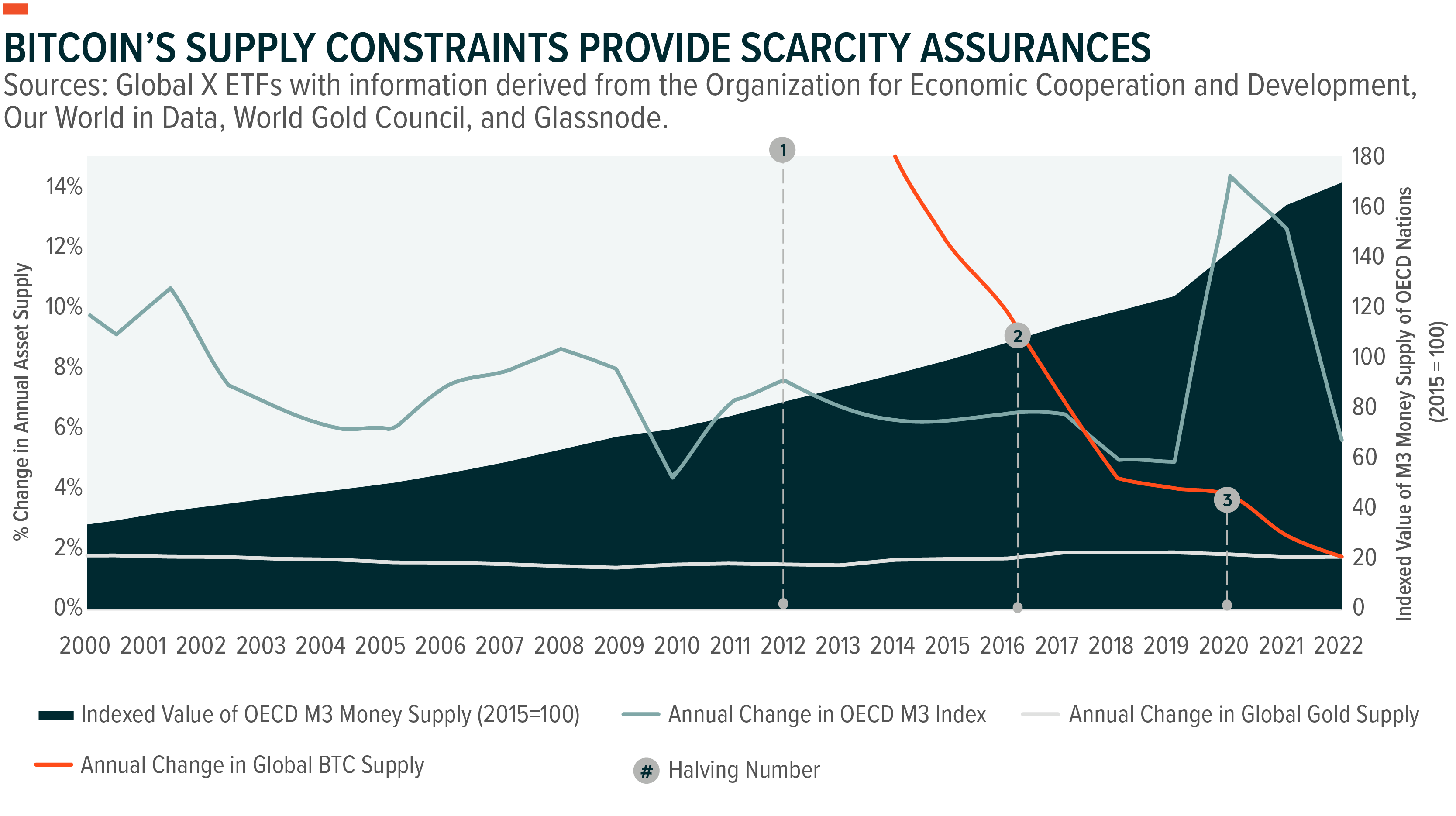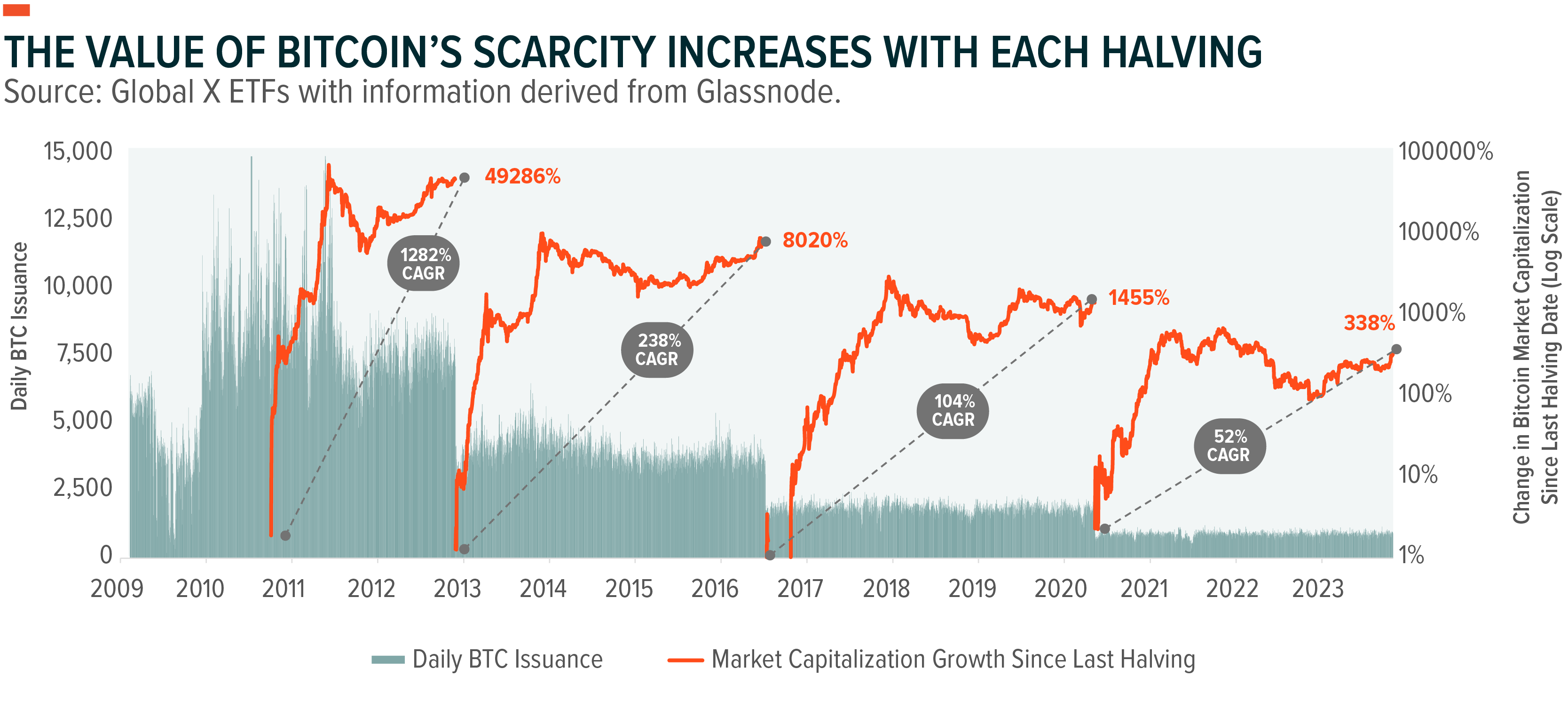Within the fast-paced, ever-changing realm of digital assets stands a single, unchanging pillar. Bitcoin, the first cryptoasset, distinguishes itself by its decentralized nature, avoiding control by any singular entity. Supported by a finite supply and a high cost of production, scarcity is an integral component of bitcoin’s value proposition. In this blog post, we explore how the countervailing forces of supply and demand can influence perceptions of scarcity and ultimately have an outsized influence on market dynamics.
This piece is part of a series that dives deeper into this year’s iteration of our flagship research piece, Charting Disruption.
Key Takeaways
- Gold and bitcoin are defined by rigid supply constraints and a high cost of production, resulting in stable and predictable supply schedules.
- Bitcoin’s scarcity is supported by the Halving which reduces bitcoin’s annual issuance rate by 50% approximately every four years. Historically, the Halving has resulted in significant price appreciation of bitcoin in the year following the Halving.
- With the next Halving scheduled for April 2024, market participants expect a similarly strong reaction to bitcoin’s reduced supply.

Relatively rigid supply constraints are one of the defining attributes of effective store-of-value assets. Gold, for example, has a finite total supply that exists on Earth. That supply has been determined by the laws of astrophysics and is not at risk of manipulation. Further, the costs and operational complexities associated with gold mining mean that the process of extracting the gold remaining under the Earth’s surface is slow, resulting in a relatively stable drip of new supply into the global market each year.
Bitcoin is subject to similar constraints, but in a digital format. Rather than being dictated by astrophysical laws, bitcoin’s maximum supply of 21M tokens was hardcoded into the protocol at inception and is protected from manipulation by the laws of proof-of-work (PoW) consensus. As with gold, the process of accessing untapped reserves of bitcoin is a financially intensive process, requiring significant capital investment and subject to the operational constraints of regular adjustments to the difficulty of bitcoin mining. Together, the confluence of a finite total supply with the technical and financial restraints on mining result in smooth and predictable supply schedules for both gold and bitcoin, directly supporting their scarcity.

A key factor ensuring bitcoin’s scarcity is the “Halving.” Occurring every 210,000 Bitcoin “blocks,” or approximately every four years, the Halving reduces the annual issuance rate of bitcoin by 50%, bringing the network one step closer to reaching its terminal supply of 21m. While these regular reductions in supply are both highly anticipated and predictable, historical market behavior suggests that the impact of the Halving tends not to be fully reflected in the price of bitcoin until about a year after the event occurs.
One explanation for this significant time lag could simply be market inefficiencies resulting from the nascency of crypto markets and the relative lack of sophistication among market participants. As such, it may be that asset mispricings are not exploited as quickly as would otherwise be the case in more mature markets. While this may carry some explanatory power, another reason for the time lag is likely due to the behaviors of bitcoin miners which are among the largest and most active participants in bitcoin markets on a daily basis.
The majority of miner revenues come from newly issued or “mined” bitcoin. To raise the cash needed to cover operational expenses, standard procedure is for a miner to sell a portion of this bitcoin issuance and hold the remaining portion on their balance sheet as an investment. While this generally holds throughout the market cycle, historical data shows that in the period leading up to a Halving, miners tend to increase the amount of bitcoin transferred to exchange platforms—an indication of an intention to sell bitcoin reserves.1 This behavior is likely due to miners anticipating reduced bitcoin-denominated revenues following the Halving, incentivizing them to raise additional cash reserves while rewards are higher.
Among the largest structural sellers of bitcoin, the increased selling activity of bitcoin miners leading into the Halving seems to establish a price ceiling for bitcoin. It is only during the period following the Halving that miners revert to typical market behavior, ultimately allowing the market to move towards a higher equilibrium price that is reflective of bitcoin’s newly reduced supply.
Conclusion
The store-of-value properties of gold and bitcoin are highly influenced by perceptions of scarcity. In large part, these perceptions depend on a tightly controlled, unchanging supply, and a mechanism to control their rate of inflation. For bitcoin, history has shown that the supply shock caused by the Halving represents a significant catalyst for the price of bitcoin. With bitcoin’s fourth halving anticipated in early 2024, bitcoin will have yet another opportunity to demonstrate why it is one of the world’s most unique assets.
 Global X Research Team
Global X Research Team